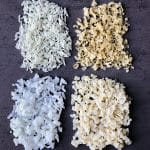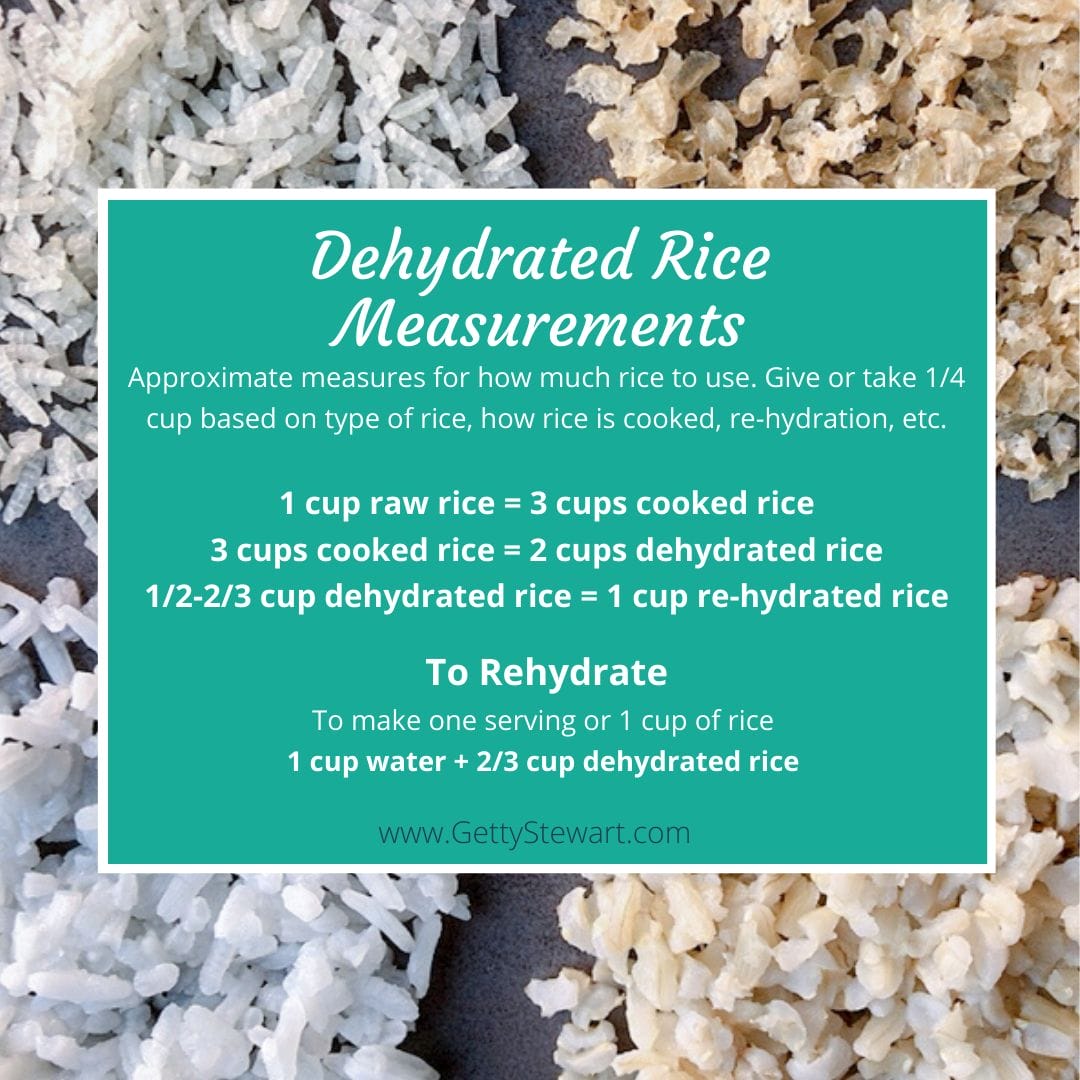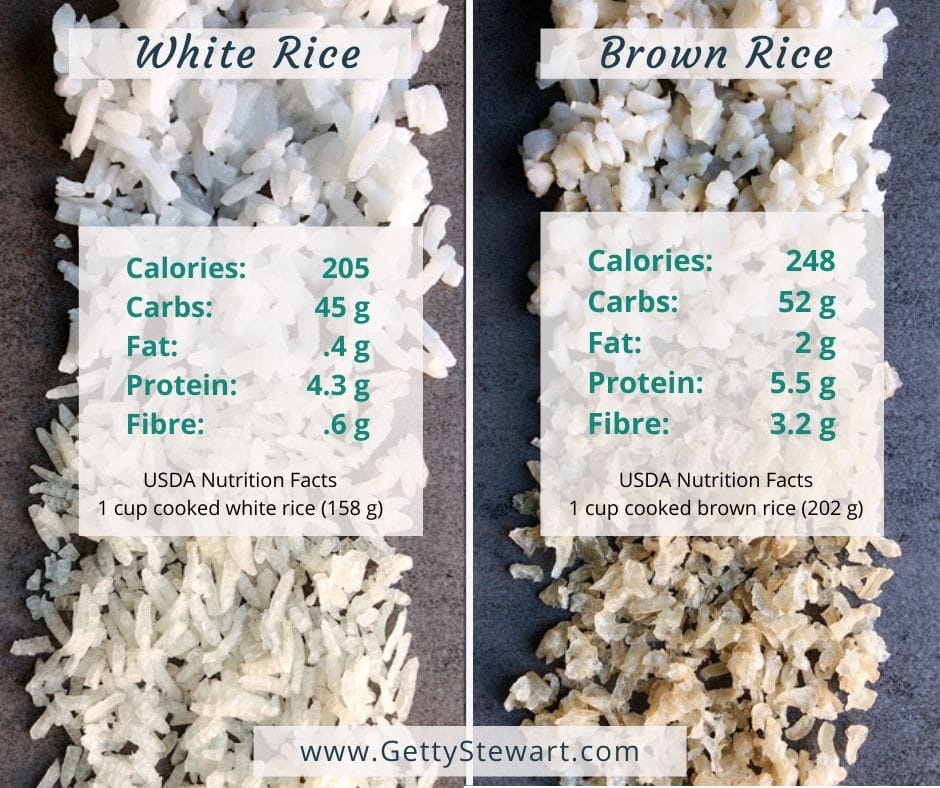How To Dehydrate Rice – White or Brown Rice
Want to dehydrate rice? It’s perfect for backcountry meals and it’s easy to do.
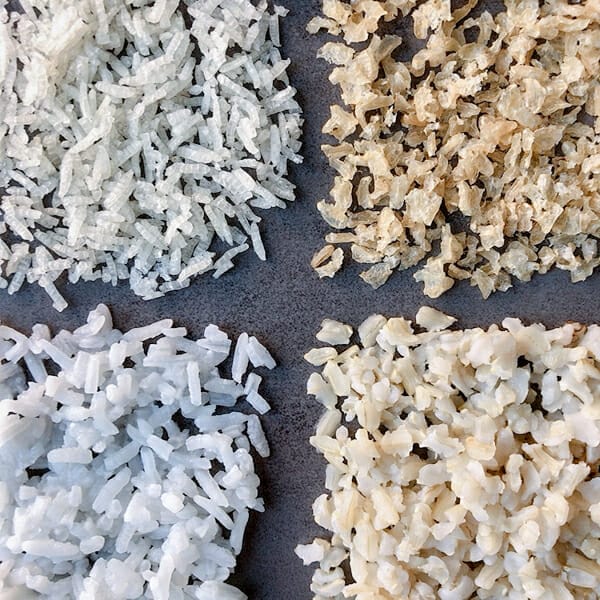
Why Dehydrate Rice?
Why would anyone want to dehydrate rice? After all, it’s already dry, it’s not that hard to cook and it’s easy to pack – why dehydrate it?
If you’re a backcountry adventurer you need food that is lightweight, quick cooking and nourishing – dehydrated rice, especially brown rice, meets all of those criteria. By cooking the rice at home and then dehydrating it, you’ll have lightweight rice that will be ready in no time. A homemade version of instant rice!
Compared to bringing raw rice, you’ll carry less weight, use (and carry) less fuel, require less time to cook supper and have less mess to clean up. All things you want on the trail.
As for commercial, boxed instant rice – I just don’t like it, so it’s not an option for me. But if you like it, go for it.
How To Dehydrate Rice
Dehydrated Rice
Ingredients
- 1 cup raw rice
- 11/2-2 cups water or no/low fat broth or as instructed on package
- 1/2 tsp salt
Instructions
- Rinse rice well until water runs clear.
- Bring water or broth to boil. Use 1 1/2 cups water for white rice and 2 cups water for brown rice.
- Add rice and salt. Cover with lid and simmer for 18-20 minutes for white rice or 35-40 minutes for brown rice (or as indicated on package). TRAIL TIP: For best results when re-hydrating on the trail, err on the side of slightly overcooked rice rather than undercooked.
- Rinse cooked rice under running water to rinse off extra starch and cool rice. Drain well.
- Spread rice as evenly as possible in single layer on lined drying trays. Liners will prevent small kernels from falling through mesh as the rice dries.
- Dry at 125°F (52°C) for 6 to 8 hours. Drying time will vary with humidity and type of rice.
- When checking on rice, break up any clumps that form to ensure even drying.
- Rice is finished when it is translucent and hard all over.
- Let cool on trays for minimum 1 hour.
- Break any large clumps and store in glass jar for up to 6 months for best quality. For longer shelf life, use oxygen absorbers, vacuum seal and keep in consistent cool and dark environment. Note: Brown rice has a shorter life span due to it's higher fat content.
- Use dried rice on its own or add to assembled dehydrated meals like Red Thai Curry, Brown Rice Porridge, Ham and Rice, Fiesta Rice, etc.
Re-hydrating Rice - 1 serving ( about 1 cup of cooked rice)
- In cooking pot, bring 1 cup water to boil. Add 2/3 cup of dehydrated rice. Turn off heat, cover and let rest for 12 to 15 minutes until rice is soft and water has been absorbed. If needed, return to heat just to warm up.
- White rice will re-hydrate a little faster (12 min) than brown rice (15 min) and the final volume may vary from 1 to 1 1/4 cup of finished, cooked rice.
Notes
Read Here for more info on My Favorite Dehydrator, The Excalibur
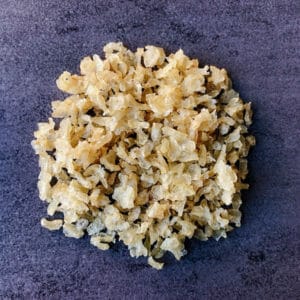
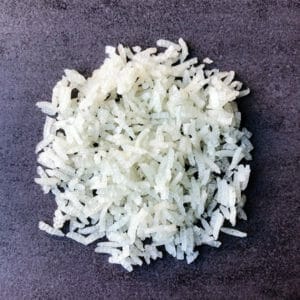

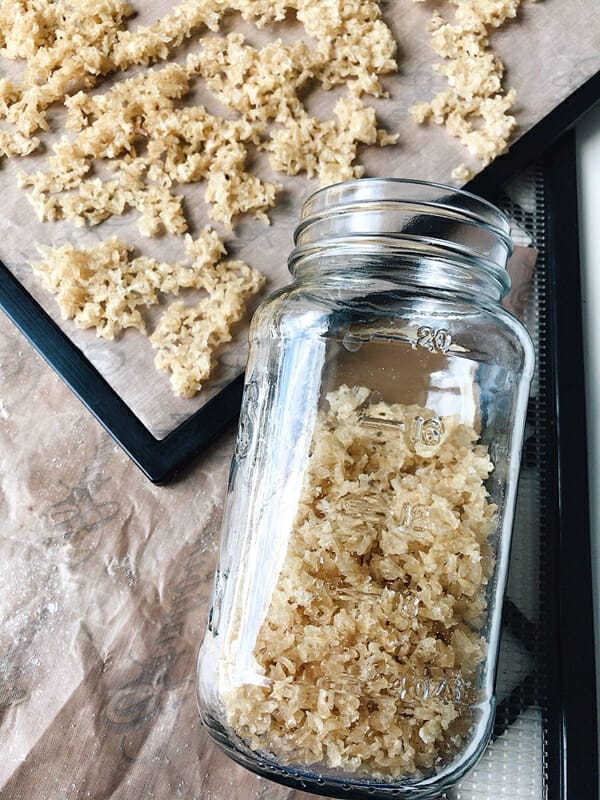
Figuring Out How Much Rice You Need
It’s hard to pin point exact numbers when it comes to cooking, dehydrating and re-hydrating rice, there are just too many variables. Plus, you may eat more or less rice per meal than I do, so who’s to say. That said, the following are some general guidelines you can use to come up with what works for you.
How to Rehydrate Rice
Whether it’s rice, soup, hummus or curry – the most important tip for re-hydrating food is to GIVE IT TIME! Just think, it takes 6-8 hours to get all the water out, it’s going to take a little bit of time to put it back in! Be patient – go set up your tent or something.
Here’s the general drill for re-hydrating rice.
Boil 1 cup water.
Add 2/3 cup dried rice.
Stir and cover. Put in cozy or wrap in towel to keep warm.
Let rest for 15 minutes.
Stir and test. If it’s still crunchy but all the water is gone, add more water and wait. If it’s ready, but there’s too much water either drain the water or wait a little longer.
If rice has cooled too much, reheat for 1-2 minutes.
Here’s a look at one of my favorite meals using dehydrated rice.

Check out some of my other dehydrating recipes and tips here Dehydrating.
Let’s Talk About Brown Rice
I’m a big fan of whole grains – the ones with all their parts in tact – the bran, endosperm and germ. Whole grains are more filling and offer more protein, fibre, fats, vitamins and minerals than their refined counterparts. If you’re going to eat rice, wheat, barley, oats, etc. why not eat the most nutrient rich version you can? At the very least, why not mix it up a little?
Once cooked and dehydrated, brown rice re-hydrates and cooks up just about the same as white rice and only requires a couple more minutes of soaking time. If you’re looking for more nutrients like protein, fibre and healthy fats – it’s the way to go.
What about arsenic in rice?
Yes, there are trace amounts of arsenic in both white and brown rice. It is higher in brown rice because it is absorbed by the outer layer or bran, which is removed in white rice. That doesn’t automatically mean it’s dangerous and we shouldn’t eat it – read on.
Rice absorbs the arsenic from the soil or the water that is used in the fields whether grown in Asia, India or the US. It does not matter if the rice is grown organically or not, arsenic is found in all types of rice. The arsenic may be naturally present or occur due to contamination from human practices such as the use of pesticides or chicken feed. Arsenic lasts a long time, for example, insecticide use in cotton fields in the 1970’s in Louisiana (no longer used today), may still contribute to arsenic levels in rice grown in that area today. Rice absorbs arsenic more readily than other whole grains, likely because of the way fields are flooded with water.
Does this mean we shouldn’t eat rice, especially brown rice? As with most things, it’s all about how much you take in, you know “the poison is in the dose”. How much rice do you eat? How many rice cakes, rice crackers, rice cereals, rice pudding, rice bars, etc. do you eat? Yes, anything made with rice has trace amounts of arsenic.
Unless you are eating rice several times a day, every day of the week, you really don’t need to worry. The exception is for infants, pregnant women and children under 6. This cohort should be careful about their consumption of rice cereal, rice crackers, rice beverages, etc. A 2016 report by the FDA goes into much more detail on potential dangers and risks.
There are no specific recommendation about how much rice you can eat per day or per week. The US, Canada and EU all recommend eating a variety of grains. We know that a healthy, balanced and varied diet is important to help ensure that a full range of essential nutrients are consumed. The emphasis on varied diets would counter a reliance on one grain, or excess intake of any one food, and include choosing a wide variety of grains.
In my house, we eat a mix of white and brown rice. We eat rice once, maybe twice a week plus the occasional box of rice crackers and brown rice cereal. I am not concerned about the levels of arsenic in our diet from rice. And I still like the benefits offered by brown rice versus white rice – so we will continue to eat both. In moderation and in addition to other whole grains like quinoa, barley, wheat and oats.
I’ll do the same on the trail – a mix of all the grains including brown and white rice.
What do you think? Will this change how, what type or when you eat rice?
Getty Stewart is a Professional Home Economist, speaker, frequent media guest and writer dedicated to putting good food on tables and agendas. She is the author of several recipe books on enjoying and preserving fruit, Founder of Fruit Share, a mom and veggie gardener. Sign up to get articles by Getty delivered to your inbox. You’ll get recipes, practical tips and great food information like this.
Getty Stewart is a participant in the Amazon Services LLC Associates Program, an affiliate advertising program designed to provide a means for sites to earn advertising fees by advertising and linking to Amazon.com.


